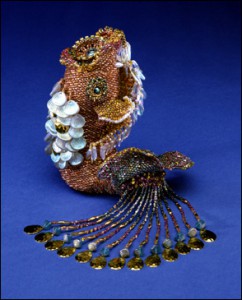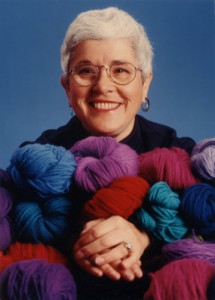Ina Golub, an award-winning Judaica artist whose weaving and beadwork are in the permanent collection of the Jewish Museum of New York and many congregations nationwide, died today in West Orange, New Jersey, from complications resulting from throat cancer. She was 76.
Ina was my aunt. She was the only notable relationship I had on my mother’s side of the family; my grandparents died early, and Ina and her husband, Herb, did not have children.
Going to their house was a much different experience than being in my own home. Ina and Herb were into the fine arts. He was a concert pianist and university professor; she, of course, was a weaver, and later a beadworker.
As a kid, stepping into their home was fascinating: the pianist rehearsing downstairs, the huge looms taking up two bedrooms, the balls of yarn and professional-grade drawing tables, the reel-to-reel playing classical music, the Eames recliner. Her house, never renovated, always stood out in my mind—the polished-brick entryway floor, the thick carpeting, the purple accents everywhere, and the dog, always a dog, a succession of fluffy Shetland sheepdogs when I was young (named Sebastian and Amadeus, naturally) and later an adorable rescue.
I spent hours drawing with high-end colored pencils in Ina’s studio, encouraged by her continual focus on creativity. Ina, my mother and I all inherited some of my grandfather Irving’s creative genes—Ina most of all, by far, but enough trickled down that Ina saw her lineage in me, and welcomed my explorations and curiosity.
Once a year, she’d drive me into New York from the suburbs, and we’d spend the day on the Upper West Side, poking around the dinosaurs at the Museum of Natural History, and occasionally exploring the flea market on Columbus Avenue and the curio store Maxilla and Mandible. Decades later, I now live in the neighborhood, and I think of my aunt every time I bring my sons to the museum.
 Ina was immensely talented in a variety of physical media. Her “Adon Livyatan”
Ina was immensely talented in a variety of physical media. Her “Adon Livyatan”
Havadalah Spice Container (right) won first prize from the 1998 Philip and Sylvia Spertus
Judaica Prize. Her tapestries hang in congregations like Emanu-El in New York, Congregation Beth Am in Los Altos Hills, California, and at several synagogues in her home state of New Jersey, including my mother’s own congregation.
I am honored to possess a variety of Ina’s works, including a woven challah cover and an astounding pair of beaded candleholders. Ina also created a pomegranate encasement that contained the ceremonial glass that I broke at my wedding ceremony, and the tallis in which I was bar mitzvahed and married. They are among my more cherished personal belongings.
Ina is survived by her sister, Myrna, and a lasting body of work that should be her legacy.
